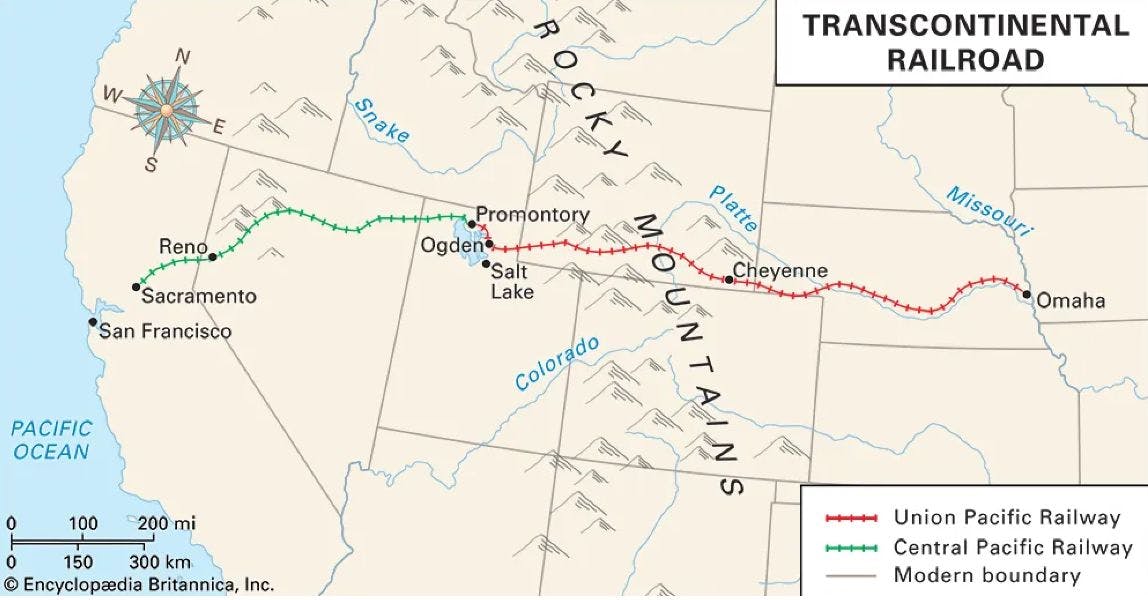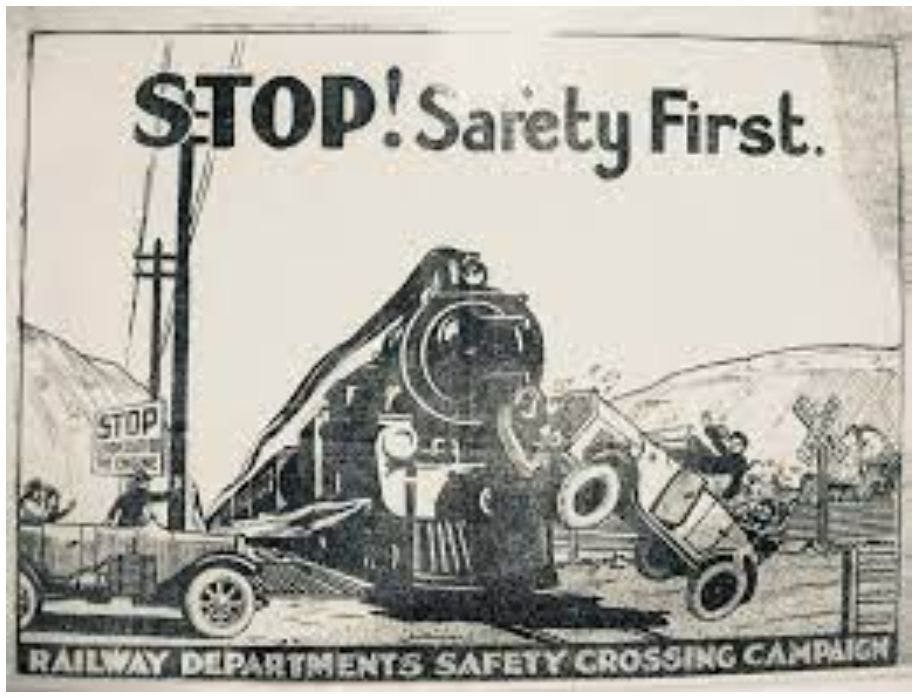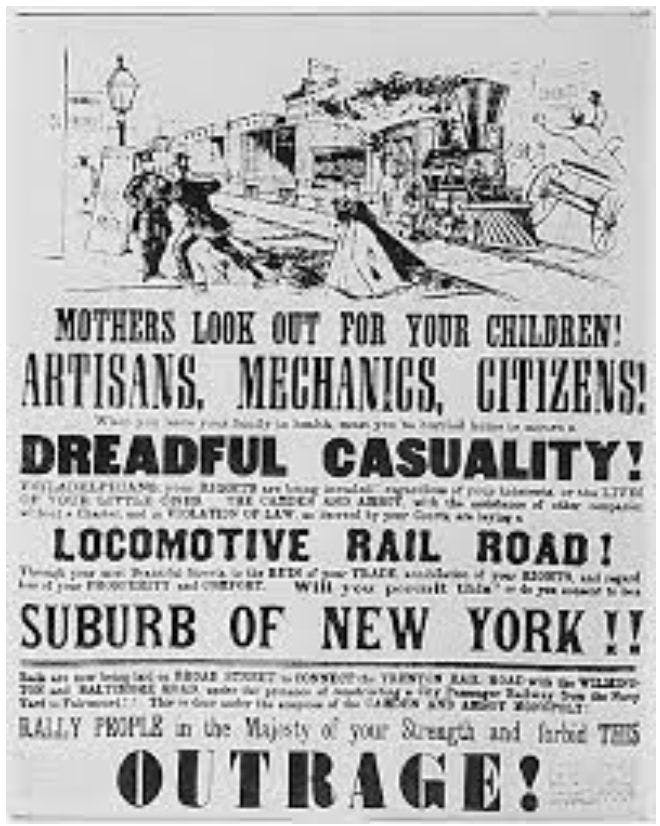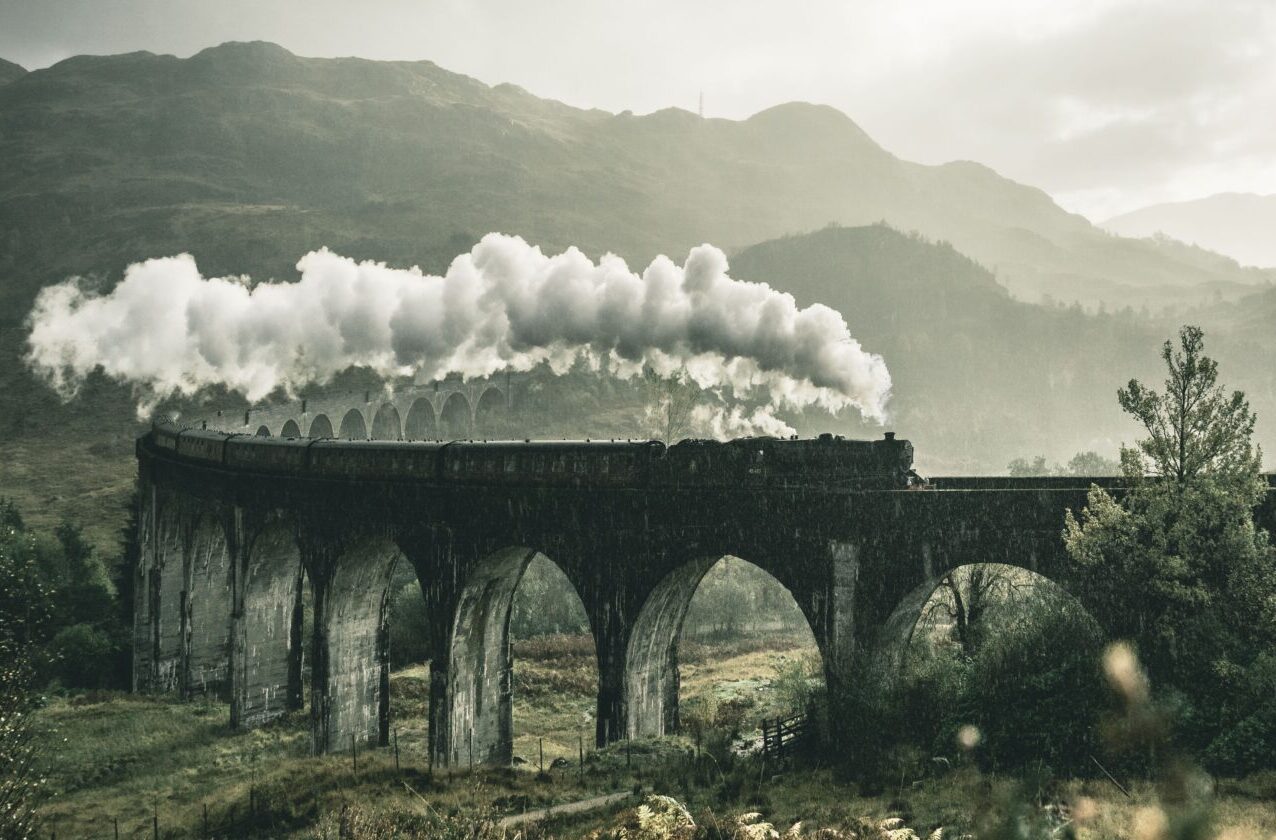A curious truth: we get so hooked on imagining the future that we forget to look to the past for guidance.
This article looks back in time at the history of the development of the railroad infrastructure that took place during the 19th century.
Worldwide, railroads became the backbone of the Industrial Revolution and laid the early groundwork for our mobile, supply-chain dependent, modern quality of life.
There are unique layers of history here that give us case studies for adapting to new technologies.
As we grapple with advancements being built in cyberspace, from Bitcoin to Generative AI to burgeoning data science fields (just to name a few), understanding the extreme change the railroads brought can help us make sense of the extreme change we’re dealing with now.
I’ll start by saying that it’s impossible to understate the impact of the Transcontinental Railroad Networks.
As we’ll see later in this article, railroad networks laid the transportation foundation for what would become the Industrial Revolution – an era that revolutionized virtually every aspect of human existence from production methods to social structures. Without this leap, it’s unlikely we’d enjoy the quality of life we currently do.
Consider the steam engine, a key innovation that not only propelled factories and revolutionized transportation, but also served as the bedrock for today’s intricate global supply chains. In a similar vein, the telegraph enabled near-instantaneous communication over vast distances, foreshadowing the intricate web of digital connectedness we have today.
The Industrial Revolution signaled a new epoch of innovation, forging a path towards the impressive advancements and conveniences that now pervade our daily lives.
If you’re a history of tech nerd like me, this story presents a wealth of intellectual intrigue.
How the American Transcontinental Railroad happened
The idea of a Transcontinental Railroad had been tossed around and debated for decades. There was just so much to disagree on.
Who would pay for it? Who would build it? Where would it begin? Where would it end?
Notable proponents like Asa Whitney and Theodore Judah played a role in pushing the ball forward, publishing and revising formal proposals and planting the seeds in the minds of high-level politicians in Congress to take up the project.
But it wasn’t until Abraham Lincoln saw it as an opportunity to connect the country in the wake of a bloody Civil War that the project started to get taken seriously.
Other leaders felt that the timing was way off. Lincoln was pressing for the country’s most ambitious project to date in the midst of an expensive Civil War.
But Lincoln was determined. In one of the most impactful pen stroked in U.S. history on July 1, 1862, Lincoln signed into existence two things:
- The Transcontinental Railroad itself
- A major player in the rail industry that’s still in operation today: Union Pacific
In Lincoln’s mind, the project would solve a number of problems. It would give settlers a passage west that was safer and more dependable than stagecoach or by ship. It would support the growth of new communities on the frontier. And, perhaps most importantly, it would bring California and Oregon closer to the rest of the country.
Complex policy and financing behind the Pacific Railway Act of 1862 granted the job of laying the railways to Central Pacific (who would build from west to east) and Union Pacific (who would build from east to west).
The government paid the two companies with land grants, bonds, and cash to incentivize them to lay as much track as possible as fast as possible.

After 6 years of non-stop sledgehammer swinging, dynamite explosions and highly-toxic nitroglycerin detonations, the ceremonial “Golden Spike” was drilled into the ground.
Days later, the first passenger service began.
Travel between New York City and San Francisco – previously a hazardous trek that took months to complete – now took less than one week.
This vital new artery linking the American heartland to the bustling cities of the east set in motion a series of profound changes that would reverberate through every aspect of life.
In essence, it irrevocably altered the American experience.
Travel, shipping, commerce, settlement, agriculture, and infrastructure all expanded into the vast American west. The perils of the Oregon and California trails subsided considerably, making it feasible for ordinary citizens to venture westward and populate the “Great American Desert.” Time zones became standardized.
A lesser-known aspect of this tale is how the rail infrastructure served as a foundation for other burgeoning networks. Telegraph systems were constructed alongside the tracks, essentially piggybacking on the rail networks. Towns situated along the railways flourished into thriving trade hubs.
Subsequent infrastructure emerged in the wake of the rail system, giving rise to networks that built upon it. The telegraph and, eventually, fiber laid by tech giants like Google exemplify this layered progression.
And this was happening all over the world, not just in the United States.
Fast forward three decades to 1891, when the Trans-Siberian Railway emerged, stretching from Moscow through the immense Siberian wilderness to Vladivostok on the Pacific coast. Addressing many of the same challenges faced in the United States, this railway upgraded Russia’s transportation infrastructure, previously reliant on a hodgepodge of roads and waterways.
Spanning the immense nation, this was Russia’s most ambitious engineering feat at the time. A staggering 62,000 workers constructed railways across the country, with some sections witnessing up to 372 miles of track laid per day— a far cry from the Union Pacific Railroad’s 40 miles in its initial six months.
The fascinating tale of the Trans-Siberian Railway’s conception and construction can be found here.

What truly piques my interest, however, are the striking parallels between the two countries in terms of their impact on people and settlement.
In Russia, pioneers journeyed eastward, while in the United States, they ventured west.
In both cases, the promise of cheap land and a fresh start was enough for many to pack their bags, hop on the train, and never look back. These railways provided a respite from the widespread financial exclusion and deplorable living conditions in overcrowded cities.
I won’t pretend the new rail networks didn’t come with their own set of difficult trade-offs. With new technology, the aim is to maximize the good and minimize the bad; and railroads managed to strike a reasonable balance.
As with many technological breakthroughs in history, there were groups who staunchly opposed the development of railroads.
The unmatched speed of trains, compared to horse-drawn carriages, initially stirred worries about potential health risks, such as respiratory issues, dizziness, and even the bizarre notion of women’s uteruses dislodging.
These apprehensions were eventually debunked as train travel gained popularity and people adapted to this novel mode of transportation.
Individuals like English poet William Wordsworth were more justifiably concerned about the environmental consequences of railways. He contested their construction in England’s picturesque Lake District, fearing the destruction of the landscape and the disruption of pastoral serenity. In 1844, Wordsworth voiced his objections in the sonnet “On the Projected Kendal and Windermere Railway.”
People initially feared rail travel due to steam engine safety concerns and accident potential. Early accidents, like the 1830 death of British Parliament MemberWilliam Huskisson, intensified these fears. However, as safety standards improved and accidents declined, public confidence increased. While concerns are valid, resisting technological progress to preserve the status quo is not beneficial.


Thomas Telford, a distinguished 19th-century civil engineer, championed canals and roads over railroads, arguing they were more cost-effective and efficient for transporting goods. He also expressed doubts about the safety of rail travel. Although not driven by financial motives, Telford’s professional reputation, tied to canals and road infrastructure, may have influenced his perspective on railroads. This serves as a reminder that even experts can err when deeply rooted in a specific way of thinking.
History may not repeat itself, but it often echoes, as seen in the parallel developments of rail infrastructure and our contemporary digital infrastructure.
This brings us to my central question in this article:
What can we learn from the development of railroad infrastructure to guide the adoption of breakthrough technologies today?
- Open infrastructure is the key to change, as demonstrated by the construction of rail networks that people could willingly join or ignore. This required an open network that individuals could freely participate in.
- Technology has always been humanity’s most significant socioeconomic driving force, distinguishing us from other species since the Stone Ages. We’re wise to not take these decisions lightly.
- Generations can often be defined by the technologies they introduce. Although new technologies can initially appear frightening and strange, the good ones eventually gain mainstream acceptance.
- Dismissing new technologies solely because they’re unfamiliar is counterproductive at best, destructive at worst.
- New networks give rise to new cultures. The rail networks opened up unprecedented opportunities, just as digital technology is doing today. The internet, for example, has created new lifestyles and opportunities for a generation of independent information workers who leverage our global digital infrastructure.
- Throughout history, each generation seems to face their own unique challenges in introducing new technologies. While ours grapples with the internet, AI, bitcoin, among a host of others on a list too long to name, previous generations wrestled with locomotives, railroads, and electricity. These technologies, once heavily debated, have now become deeply ingrained in society. Viewing history through the lens of “defining technologies” offers a fascinating perspective on human progress.
Note: I know there are a ton of new technologies I’m not naming in this article, as I’m aware there are many. I stick with the ones I have the deepest understanding of, but that doesn’t mean they’re the only ones making great progress.
This article was originally published by Brooks Lockett on Hackernoon












